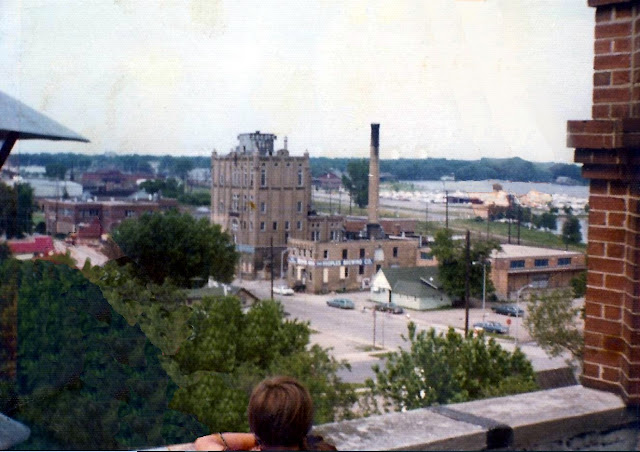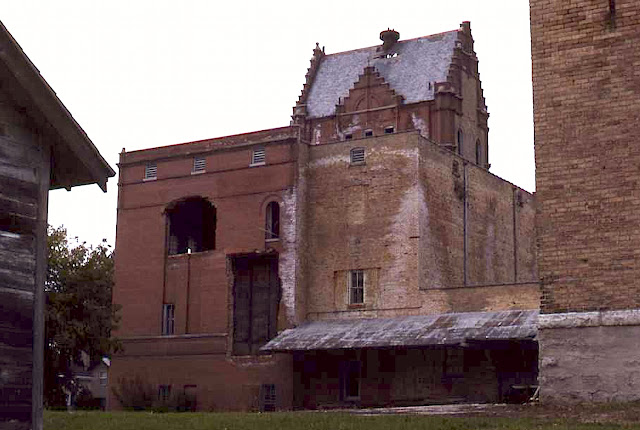 |
| Dan Rothe on the left in 1973 with a neighborhood friend. |
“Peoples was the first one,” Rothe says. “They had a little slide-up door by the loading dock, and it had been left open. We went in and ended up where the canning line was. Mind you, I had never been in a brewery before, and at that time me and just about everybody else my age collected beer cans. So seeing all that stuff in there, I remember being just wowed by it. It was like a time capsule. It was like they just shut down, put their gloves on the rack, and walked out.”
 |
| Peoples Brewing Company, circa 1973 |
Peoples Brewing Company, in the 1500 block of South Main Street, had closed in 1972. The facility was being left unattended by the time Rothe and his friends found their way inside.
"And we got caught by the police that very first time," Rothe says. "All of a sudden we hear 'All right kids come on out.' What? I tried heading out the door at the back of the brewery. I grabbed the handle of the door to open it, but it wouldn't open. All of a sudden the handle turns by itself. I wipe the glass and I can see the badge on his cap and I was like, oh man. They had us.”
“Our parents had to come down to the police station. Boy, did they run it up the flagpole. They said they were going to charge us with all kinds of stuff. They were just trying to scare the heck out of us. They did a good job of it. When we got out of there I remember my dad saying, 'Don't you ever go into that brewery again.' OK. So, about a month later, we went into the Chief Oshkosh Brewery."
 |
| Left for dead. The former brewery of the Oshkosh Brewing Company. |
Across the street from Peoples stood the Oshkosh Brewing Company's abandoned brewery. The former home of Chief Oshkosh Beer had closed in 1971. Like Peoples, it was left unguarded. "You didn't break into that one," Rothe says. "You just walked in." Rothe would return time and again to the two breweries during the summers of 1973 and 1974.
"The inside of these breweries had an attraction to them. I mean all these mechanical can lines and these steam pipes, and there's all these old windows and huge vats, nice and copper and round. For a boy, it was just irresistible."
 |
| Inside the Oshkosh Brewing Company in the 1960s. |
“Peoples was cool, but it was a small brewery. The Chief Oshkosh Brewery was a whole different story. It had all these different levels. It was enormous. But you had to be careful there. There was a hole that rotted through the ceiling of the tower. It let the water in and it rotted the steps up to the tower. We used to go climbing up there. You could watch the planes fly over through that hole in the roof during EAA."
"There was an office area with a safe with an arrowhead on the door that was swung open. It was just a mess. Paperwork was everywhere. There were beer labels all over the place. Beer cases, bottle caps. Once, I found an old Rahr's sign in there. It was at night. You ever try going over a bridge on your bike with a five-foot sign? I did it. I lived on the west side. That was a long ride."
As the adventure grew, the brewery excursions became more elaborate. They sometimes resembled a boy's version of a pirate raid.
"My friend had a 14-foot aluminum boat. He lived along the river on Adams. We'd take the boat down the river when it was getting dark. There were no running lights on it. We'd take the river into the lake and go ashore behind Peoples. When we were coming out of the Oshkosh brewery we'd watch for the headlights on cars on South Main. We didn't want anyone to see us coming out of there. When the cars passed, we'd run like crazy across the street and up over the train tracks and down onto the shoreline into the boat, and away we went."
Rothe and his friends weren't the only kids haunting the deserted breweries. "We'd run into other people," he says. "There were kids who would go in there and they’d just destroy it. It's unfortunate the abuse those buildings took inside. We didn't do that. We never went in and smashed stuff or busted stuff up. We didn't go in there to cause damage. We were exploring."
"My friend had a 14-foot aluminum boat. He lived along the river on Adams. We'd take the boat down the river when it was getting dark. There were no running lights on it. We'd take the river into the lake and go ashore behind Peoples. When we were coming out of the Oshkosh brewery we'd watch for the headlights on cars on South Main. We didn't want anyone to see us coming out of there. When the cars passed, we'd run like crazy across the street and up over the train tracks and down onto the shoreline into the boat, and away we went."
Rothe and his friends weren't the only kids haunting the deserted breweries. "We'd run into other people," he says. "There were kids who would go in there and they’d just destroy it. It's unfortunate the abuse those buildings took inside. We didn't do that. We never went in and smashed stuff or busted stuff up. We didn't go in there to cause damage. We were exploring."
 |
| Looking west towards Peoples Brewing from the Oshkosh Brewing Company in 1974. Photo courtesy of Dale Hunt. |
The adventure came to an end in the summer of 1974 when Rothe was 14. The demolition of the Peoples Brewing facility began in July of that year. The decayed remains of the Oshkosh Brewing Company were razed in 1986.
 |
| The start of the demolition of Peoples in 1974. |
"I remember when Oshkosh got knocked down," Rothe says. "I was older then. It was a shame what happened there. There were big gaping holes smashed through the side when they took the vats outs. It was gutted. It was a skeleton, basically caving in on itself."
"But before all that, some of us just had one hell of a good time in there. If I could go back to 1974 and it was the same situation I'd be right back in there. I don't think kids get these kinds of experiences anymore. It's hard to explain. It's one of those things where memories are everything. That's all that's left."
 |
| Dan Rothe |
End Note
Last year, I wrote a piece about the long decline of the Oshkosh Brewing Company’s brewhouse. You can find that here.














